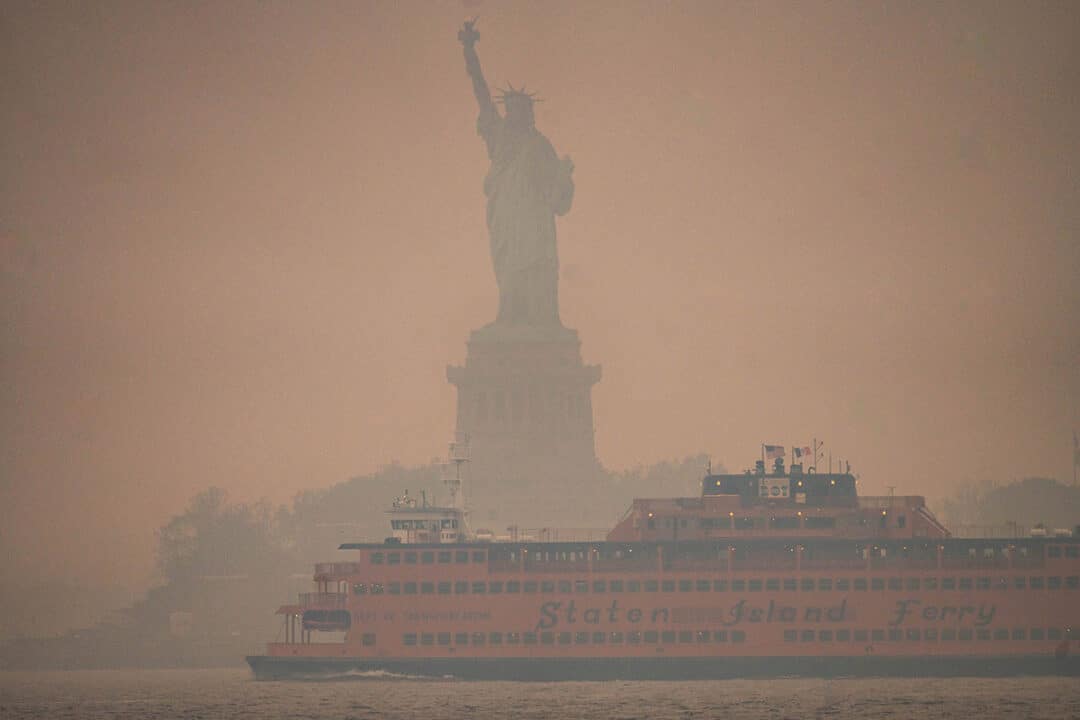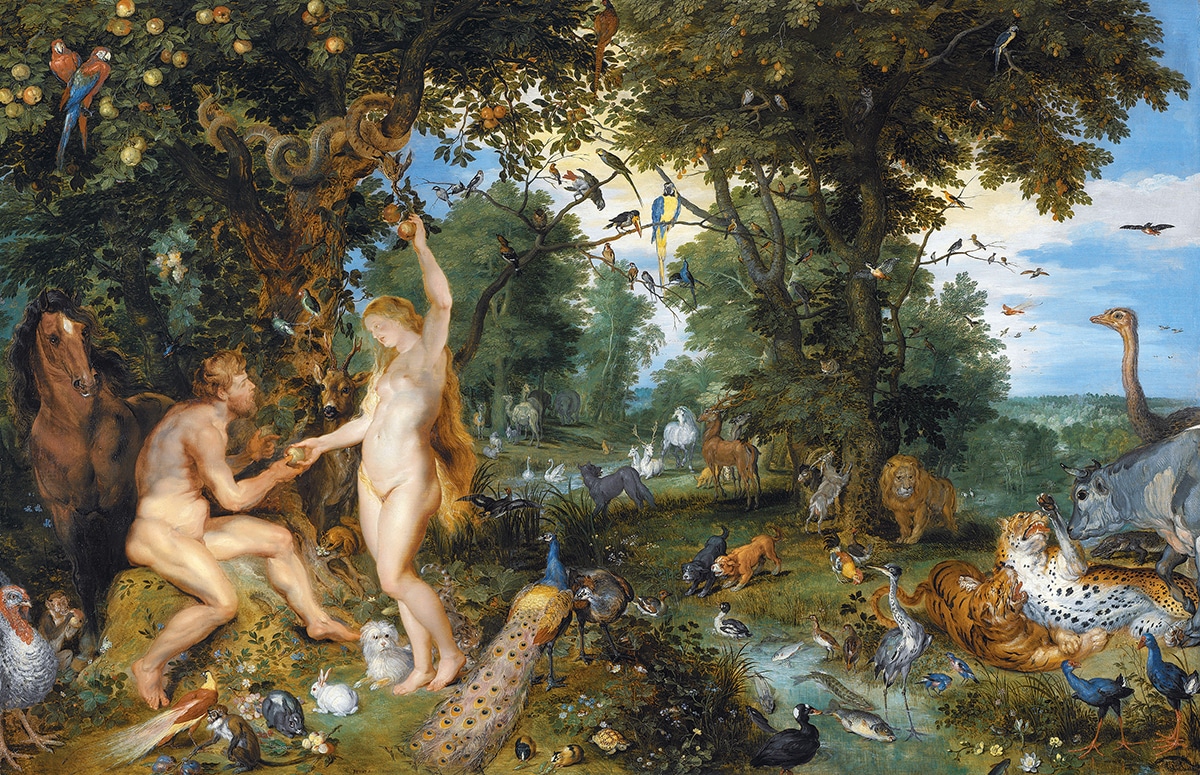

Economics v. the Earth: New Book Explores the History of a Tense Relationship
On June 7, 2023, New Yorkers ventured outside to find their city choked in putrid orange smog that blocked the light of day. Smoke blown south from drought-fueled Canadian wildfires eventually dissipated, only to return as a brownish haze just in time for Fourth of July weekend. Many celebrants canceled their outdoor plans.
‘We are truly the first generation to feel the real effects of climate change,” said New York Governor Kathy Hochul. Big Apple inhabitants, already getting used to fretting about destructive hurricanes stoked by warmer oceans, now add out-of-control forest fires burning hundreds of miles north to their list of climate anxieties. It’s getting harder to ignore the possibility that if their children lived to the year 2100, they might see actually New York City lost to rising seas, along with Mumbai, Shanghai, and Miami.
Canadian fires sent a smoke signal: the path of Western capitalism, which runs right through Wall Street, could end in a climate apocalypse.
In their new book, Scarcity: A History from the Origins of Capitalism to the Climate Crisis, historians Fredrik Albritton Jonsson and Carl Wennerlind warn that capitalist societies will have to overhaul the way we interact with the planet in order to avoid unthinkable consequences. They trace the key economic concept of scarcity as it developed over five hundred years of European thought, showing how a particular interpretation helped bring us to the trouble we’re facing.
The relationship between the economy and nature has been considered by thinkers all the way back to Aristotle. But as Jonsson and Wennerlind show, the topic gained center stage in the seventeenth century in the form of a new enthusiasm for controlling nature. During this period, thinkers like Francis Bacon spread the notion that with the help of science, humanity could bring nature under control and force it to yield its riches. The sky was no longer the limit of our desires.
The authors divide historical views of scarcity into two camps. “Cornucopians” like Bacon held that nature could be mastered to satisfy boundless human wants – a position that found its way to dominance in the West by the end of the 19th century, most recently promoted by neoclassical economists. As Jonsson and Wennerlind see it, economists under the sway of cornucopianism came to believe in a “dream of infinite substitutability” whereby natural resources were always available, and if something grew scarce, no problem — a substitute could be found. For example, if rainforests vanished, the price of goods associated with them would increase, thus lowering demand and sparking innovation to yield substitutes.
The authors outline how over the last century, most mainstream economists have been selling the idea that what we need to do is to use natural resources efficiently and develop science and technology to maximize economic growth. The basic premise: more is almost always desirable, the cheaper the better, and we can have it all without destroying the planet. The magic of market forces would take care of any environmental problems.
The authors liken this fantasy to the fervent visions of progress among 17th-century alchemists.
Jonsson and Wennerlind refer to a second group of ideas about scarcity as the “Finitarian” tradition, focused on limits to power over nature and the need to rein in human desires. While Cornucopians pictured the economy as the engine of the endless growth of wants, Finitarians asked, what about simplicity? A meaningful life? Liberation from desire? And by the way, what about living in balance with nature?
The authors note that Finitarianism was the dominant worldview of sixteenth-century Neo-Aristotelians, a perspective that later found expression in a variety of movements, such as Romanticism. When they thought about the economy and nature, Romantics tended to emphasize living within the limits of nature as the foundation of a healthy society. They saw the Cornucopian focus on ever-rising material standards of living as missing much of what makes human life worth the journey: community, artistic expression, imagination, spirituality, and work that is not soul-crushing.
Consider the views of art critic and political economist John Ruskin, who advocated the regulation of economic development for the protection of the environment and public health. Jonsson and Wennerlind note that during the 1870s, Ruskin began to notice sinister effects of industrial capitalism in the smoke-filled skies of his country home in England’s Lake District. Unlike most of his contemporaries, he saw the potentially global reach and catastrophic dimensions of what was billowing out of factories Romantic William Blake had earlier dubbed the “dark Satanic mills.” In a series of published letters addressed to British workers, Fors Clavigera, Ruskin warned: “You can vitiate the air by your manner of life… You might easily vitiate it so as to bring such a pestilence on the globe as would end all of you.”
Talk about prescient.
Jonsson and Wennerlind’s book describes several strands of resistance to cornucopianism, from Thomas More’s Utopia to recent challenges from ecological, feminist, and anarchist thinkers.
What the world needs right now, argue the authors, is more Finitarianism. Instead of charging ahead with exploiting nature and expanding our wants, we need to repair the harm we’ve done and work to prevent further damage.
The authors point to a few economists who have begun to recognize the threat economic growth poses to the planet and the role that economics has played in driving an unsustainable approach to natural resources – but it’s a pretty short list. Their history of Finitarian movements offers blueprints for new ways of considering the economy and nature.
For current inspiration, Jonsson and Wennerlind cite the Planetary Boundaries model as a useful framework for allowing humans to thrive without exploiting and destroying nature, part of a movement to rethink the purpose of the economy. They also point to Earth System science – the interdisciplinary study of the interconnected parts of the environment — as a promising tool for recognizing how the ideologies of maximum efficiency, infinite substitutability, and infinite growth threaten the intricate processes that make the planet inhabitable.
Despite these promising signs, the authors point out that neoclassical economists still hold onto a belief in human mastery of nature that turns a blind eye to the planetary crisis.
Bottom line: Scarcity warns that if we stay bent on harnessing nature to fulfill our limitless desires, those desires won’t matter much because in the end we’ll destroy ourselves, and a lot of the natural world, too. Our ignorance of nature’s complexities, plus the continuation of harmful economic ideologies, threaten the stable functioning of Earth, but with Finitarian approaches, Jonsson and Wennerlind are hopeful that we can envision a future beyond the endless multiplying of our material wants and enter a collaborative partnership with nature.
The good news: although the authors acknowledge that the conflict between Cornucopians and Finitarians is still playing out, they write that “the planet itself now seems to weigh in on the side of the Finitarians.” Is that enough to convince mainstream economists?
Meanwhile, smoke from Canada’s wildfires has drifted down into the southern United States and as far away as Europe, covering millions in toxic haze. There is little doubt that human carelessness is a major cause of the phenomenon and that until humans can change course, we’d better get used to it.




